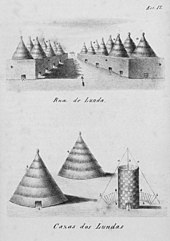The decline of Great Zimbabwe, due to increasing trade competition from other Kalanga/Shona kingdoms like Khami and Mutapa, spelt the end of Ingombe Ilede.
Second Bantu settlement:
The second mass settlement of Bantu people into Zambia was of people groups that are believed to have taken the western route of the Bantu migration through the Congo Basin. These Bantu people spent the majority of their existence in what is today the Democratic Republic of Congo and are ancestors of the majority of modern Zambians.
While there is some evidence that the Bemba people or AbaBemba have a strong ancient connection to the Kongo Kingdom through BaKongo ruler Mwene Kongo VIII Mvemba, this is not well documented.
Luba-Lunda states:

Over time these communities learned to use nets and harpoons, make dugout canoes, clear canals through swamps and make dams as high as 2.5 meters. As a result, they grew a diverse economy trading fish, copper and iron items and salt for goods from other parts of Africa, like the Swahili coast and, later on, the Portuguese. From these communities arose the Luba Kingdom in the 14th century.
The Luba Kingdom was a large kingdom with a centralized government and smaller independent chiefdoms. It had large trading networks that linked the forests in the Congo Basin and the mineral-rich plateaus of what is today Copperbelt Province and stretched from the Atlantic coast to the Indian Ocean coast. The arts were also held in high esteem in the kingdom, and artisans were held in high regard.
Literature was well developed in the Luba Kingdom. One renowned Luba genesis story that articulated the distinction between two types of Luba emperors goes as follows:
“Nkongolo Mwamba, the red king, and Ilunga Mbidi Kiluwe, a prince of legendary black complexion. Nkongolo Mwamba is the drunken and cruel despot, Ilunga Mbidi Kiluwe the refined and gentle prince. Nkongolo the Red is a man without manners, a man who eats in public, gets drunk, and cannot control himself, whereas [Ilunga] Mbidi Kiluwe is a man of reservation, obsessed with good manners; he does not eat in public, controls his language and his behaviour, and keeps a distance from the vices and modus vivendi of ordinary people. Nkongolo Mwamba symbolizes the embodiment of tyranny, whereas Mbidi Kiluwe remains the admired caring and compassionate kin.”

The Lunda, like its parent state Luba, also traded with both coasts, the Atlantic and Indian Oceans. While ruler Mwaant Yaav Naweej had established trade routes to the Atlantic coast and initiated direct contact with European traders eager for slaves and forest products and controlling the regional Copper trade, and settlements around Lake Mweru regulated commerce with the East African coast.
